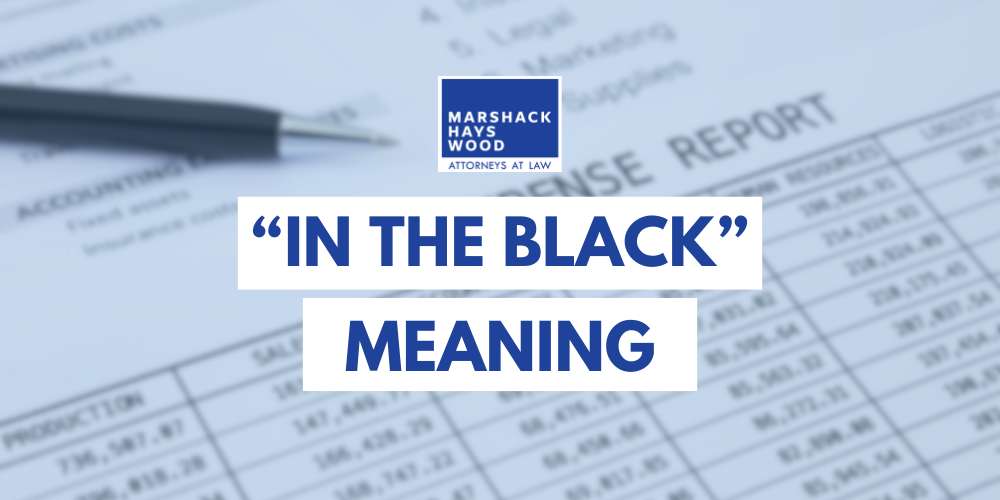Dealing with the many challenges and nuances of personal finances can often feel like deciphering a foreign language, especially when confronted with unfamiliar terms like “in the black.” Here at Marshack Hays Wood, an Orange County bankruptcy law firm dedicated to guiding individuals through financial challenges, we understand the importance of demystifying financial jargon.
In this blog post, we delve into the “in the black” meaning and its significance in managing one’s financial health. Whether you’re striving to regain stability or simply seeking clarity on financial terminology, we’re here to provide insights and support every step of the way. To schedule a free consultation about your financial situation, please call our office at (949) 333-7777 or reach out online to get in touch today.
What Does In the Black Mean?
“In the black” is a financial idiom that means a company or individual is operating profitably, with positive earnings or a positive balance in their financial accounts. It’s the opposite of being “in the red,” which indicates losses or debt. So, when someone says a company is “in the black,” it means they have made a profit or have a positive net worth.
Positive Earnings, or Making Money
The term “in the black” originates from the color of ink traditionally used in bookkeeping to denote profits in the most recent accounting cycle. In old accounting practices, accountants would use black ink to record positive numbers, such as profits or credits, in financial ledgers.
When a company’s financial statements showed that it had more assets than liabilities, or when its revenue exceeded its expenses, it would record those gains in black ink. Hence, being “in the black” came to signify positive earnings or profitability.
Today, while the actual practice of using physical ink may have largely faded, the term still persists as a metaphorical way to describe a financially successful situation.

Operating In the Black
Operating in the black refers to the state of a business or individual’s financial operations when they are generating profits or operating with a positive cash flow. This means that their income from sales, investments, or other sources exceeds their expenses, including costs of goods sold, operating expenses, taxes, and interest payments.
Essentially, it means that the entity is financially solvent and able to cover its costs while still having money left over. Being “in the black” is a positive indicator of financial health and sustainability.
Solid Business Performance
Being in the black indicates a solid business performance because it signifies that a company is generating profits and operating with financial stability. In some cases, a company may be “in the black” now, but not consistently year over year. Large, necessary purchases may put them “in the red” for a year or so, but the company could be “in the black” overall.
Being “in the black” indicates a solid business performance in the following ways.
- Profitability
- Financial stability
- Investor confidence
- Ability to grow
- Credibility and trust
What Does In the Red Mean?
In the red is a financial idiom that refers to a situation where a company or individual is operating at a loss or has a negative balance in their financial accounts. The term “red” originates from the practice of using red ink to denote negative numbers or losses in financial records.
When a business is in the red, it means that it has more expenses than revenue, resulting in a deficit. This deficit can indicate financial challenges, such as cash flow problems, high debt levels, or unsustainable business practices. In the world of finance, the color red usually has negative connotations.
Negative Earnings, or Losing Money
In the red indicates negative earnings or financial losses, often shown by a minus sign in a company’s books. When a business is described as “in the red,” it means that they are experiencing negative earnings or operating at a loss. This could be due to various factors such as declining sales, high expenses, poor financial management, or economic downturns. Being “in the red” is generally considered unfavorable as it indicates financial difficulties and may require corrective actions to improve the company’s financial health.

Operating In the Red
Operating in the red means that a business is experiencing financial losses or operating at a deficit. This indicates that the company’s expenses exceed its revenue, resulting in a negative balance or shortfall. When a business operates “in the red,” it suggests that it is not generating enough income to cover its costs, including operating expenses, debt obligations, and other financial commitments.
It’s important to note that some new businesses operate “in the red” for a brief period, which is normal until they can start turning a profit. However, if an established business takes on more debt than it can handle, this usually isn’t a good sign. For a business, consistently operating “in the red” can have several implications, including the following.
- Financial strain
- Risk of insolvency
- Pressure on management
- Investor concerns
In the Black vs In the Red
In the black indicates that a business or individual is operating with a profit or positive financial balance. It suggests that revenues exceed expenses, resulting in a surplus. Being “in the black” is a sign of financial health and profitability.
“In the red” signifies that a business or individual is operating at a loss or has a negative financial balance. It means that expenses exceed revenues, resulting in a deficit. Being “in the red” indicates financial difficulties or challenges. In most software for bookkeeping, negative marks are shown in the harsh color of red so they stand out more and are easier to see.

How to Get Out of the Red and Into the Black
To transition from operating in the red to in the black, companies typically need to implement strategic measures to improve their financial health and profitability. Being “in the red” for a short period may be nothing to worry about. However, consistently being “in the red” is a bad sign. Companies can work to get out of “the red” and into “the black” in the following ways:
Review Your Financial Statements
The first step is to conduct a thorough review of the company’s financial statements, including the income statement, balance sheet, and cash flow statement. This analysis helps identify areas of financial weakness, such as excessive expenses, declining revenues, or inefficient operations. This information can help the company figure out how to become profitable.
Pay Off Your Debt
Companies burdened with high levels of debt should prioritize paying off outstanding balances to reduce interest expenses and improve cash flow. This may involve renegotiating debt terms, consolidating loans, or allocating resources to repaying debts.
File For Bankruptcy
If a company cannot reorganize its finances on its own, bankruptcy can be a wise choice. Many people see bankruptcy as a last resort, but it is actually a useful tool for getting out of debt and reorganizing finances.
Analyze Your Budget
A comprehensive budget analysis can help identify areas where expenses can be reduced or reallocated to improve profitability. Companies should scrutinize all expenses, including overhead costs, operating expenses, and discretionary spending, and implement cost-cutting measures where necessary. This can help the company return to turning a profit.

Contact the Orange County Bankruptcy Lawyers at Marshack Hays Wood Today
Understanding the significance of being “in the black” versus “in the red” financially is crucial for individuals and businesses alike. While being “in the black” represents financial health and profitability, being “in the red” can signify financial distress and the need for strategic intervention.
At Marshack Hays Wood, we have considerable experience in helping individuals and businesses in Orange County navigate challenging financial situations, including bankruptcy proceedings. Whether you’re seeking debt relief, debt restructuring, or assistance with financial planning, our experienced attorneys are here to provide compassionate guidance and tailored solutions to help you achieve a fresh financial start.
Contact us today to learn more about how we can help you transition from operating “in the red” to achieving financial stability and operating “in the black” once again.

